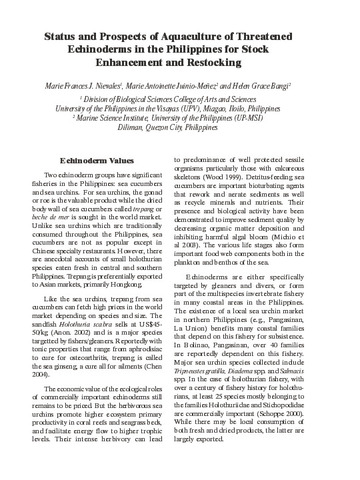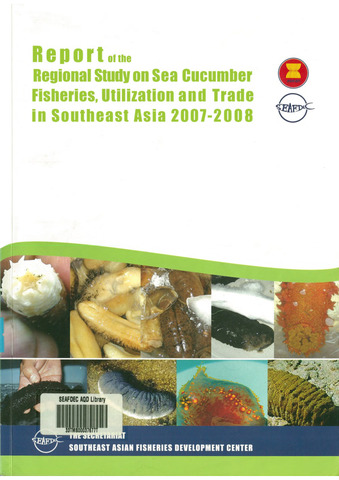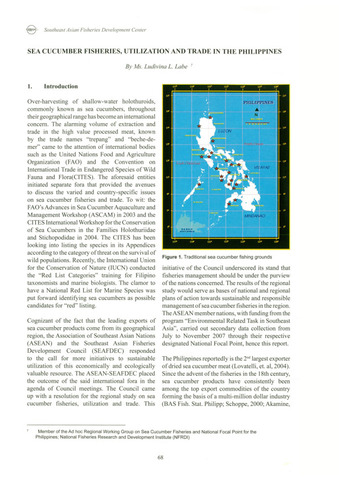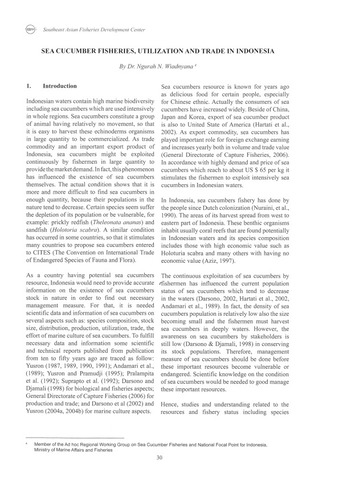Status and prospects of aquaculture of threatened echinoderms in the Philippines for stock enhancement and restocking
Share
Abstract
Echinoderms are either specifically targeted by gleaners and divers, or form part of the multispecies invertebrate fishery in many coastal areas in the Philippines. The existence of a local sea urchin market in northern Philippines (e.g., Pangasinan, La Union) benefits many coastal families that depend on this fishery for subsistence. In Bolinao, Pangasinan, over 40 families are reportedly dependent on this fishery. Major sea urchin species collected include Tripneustes gratilla, Diadema spp. and Salmacis spp. In the case of holothurian fishery, with over a century of fishery history for holothurians, at least 25 species mostly belonging to the families Holothuriidae and Stichopodidae are commercially important (Schoppe 2000). While there may be local consumption of both fresh and dried products, the latter are largely exported. Echinoderm fishery is dependent on wild stock. The high demand far exceeding supply, good global market prices and their biology (e.g., slow mobility, shallow water benthic habitat) render them vulnerable to overexploitation. The contribution of echinoderm products to the Philippine economy is substantial. The relative contribution of echinoderm products to the income and socio-economic well-being of fisherfolk who collect these invertebrates is undocumented. However, it has been noted that middlemen, especially local buyers who sell trepang in Manila and Manila-based traders-exporters monopolize the profits (F. Nievales, unpublished data). Products from both echinoderm groups remain in short supply in the country and so trading, limited only by declining natural stock, continues to be lucrative.
Suggested Citation
Nievales, M. F. J., Juinio-Meñez, M. A., & Bangi, H. G. (2006). Status and prospects of aquaculture of threatened echinoderms in the Philippines for stock enhancement and restocking. In J. H. Primavera, E. T. Quinitio, & M. R. R. Eguia (Eds.), Proceedings of the Regional Technical Consultation on Stock Enhancement for Threatened Species of International Concern, Iloilo City, Philippines, 13-15 July 2005 (pp. 61-69). Tigbauan, Iloilo, Philippines: Aquaculture Department, Southeast Asian Fisheries Development Center.
Subject
echinoderm culture  ; echinoderm fisheries
; echinoderm fisheries  ; sea cucumber fisheries
; sea cucumber fisheries  ; vulnerable species
; vulnerable species  ; nature conservation
; nature conservation  ; sea urchin fisheries
; sea urchin fisheries  ; mariculture; stock assessment
; mariculture; stock assessment  ; depleted stocks
; depleted stocks  ; hatcheries; aquaculture facilities
; hatcheries; aquaculture facilities  ; seed production
; seed production  ; stocking (organisms)
; stocking (organisms)  ; Philippines
; Philippines  ; Holothuria scabra
; Holothuria scabra  ; Tripneustes gratilla
; Tripneustes gratilla  ; Diadematidae
; Diadematidae 
 ; echinoderm fisheries
; echinoderm fisheries  ; sea cucumber fisheries
; sea cucumber fisheries  ; vulnerable species
; vulnerable species  ; nature conservation
; nature conservation  ; sea urchin fisheries
; sea urchin fisheries  ; mariculture; stock assessment
; mariculture; stock assessment  ; depleted stocks
; depleted stocks  ; hatcheries; aquaculture facilities
; hatcheries; aquaculture facilities  ; seed production
; seed production  ; stocking (organisms)
; stocking (organisms)  ; Philippines
; Philippines  ; Holothuria scabra
; Holothuria scabra  ; Tripneustes gratilla
; Tripneustes gratilla  ; Diadematidae
; Diadematidae 
Taxonomic term
Related items
Showing items related by title, author, creator and subject.
-
Report of the regional study on sea cucumber fisheries, utilization, and trade in Southeast Asia, 2007-2008
Southeast Asian Fisheries Development Center (Secretariat, Southeast Asian Fisheries Development Center, 2009)The present trend towards overfishing of sea cucumbers in diverse geographical areas to supply international market demand has become an urgent concern in the international community. There is also an attempt to conserve ... -
Sea cucumber fisheries, utilization and trade in the Philippines
Labe, Ludivina L. (Secretariat, Southeast Asian Fisheries Development Center, 2009) -
Sea cucumber fisheries, utilization and trade in Indonesia
Wiadnyana, Ngurah N. (Secretariat, Southeast Asian Fisheries Development Center, 2009)





